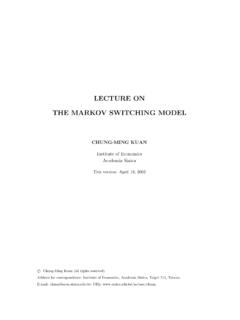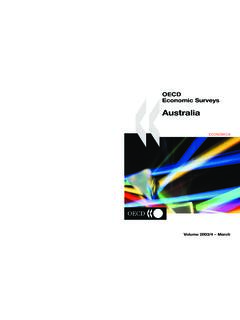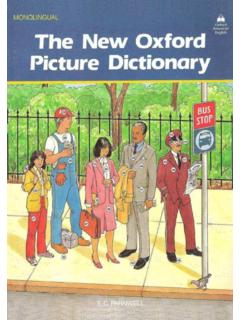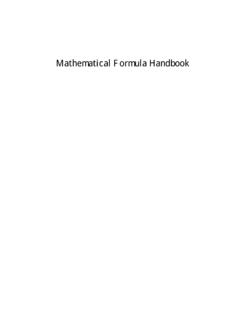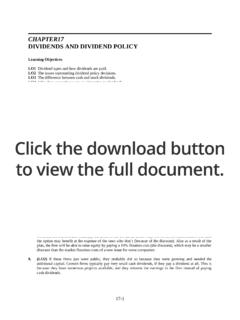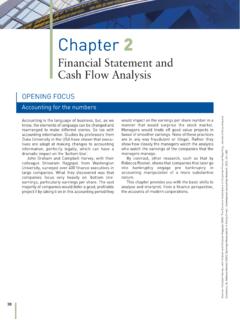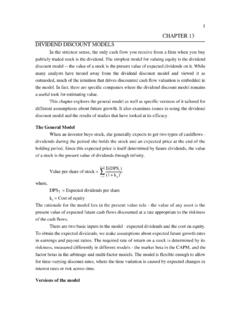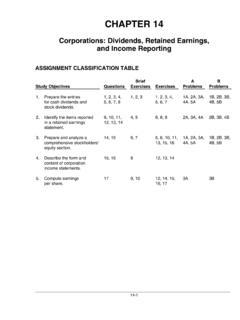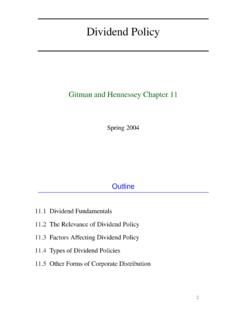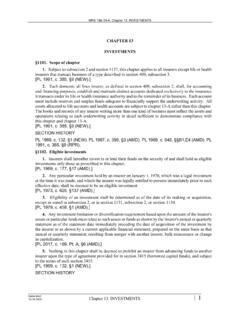Transcription of CHAPTER 18 DIVIDENDS AND OTHER PAYOUTS
1 1. CHAPTER 18. DIVIDENDS AND OTHER PAYOUTS . Answers to Concepts Review and Critical Thinking Questions 1. dividend policy deals with the timing of dividend payments, not the amounts ultimately paid. dividend policy is irrelevant when the timing of dividend payments doesn't affect the present value of all future DIVIDENDS . 2. A stock repurchase reduces equity while leaving debt unchanged. The debt ratio rises. A. firm could, if desired, use excess cash to reduce debt instead. This is a capital structure decision. 3. The chief drawback to a strict dividend policy is the variability in dividend payments. This is a problem because investors tend to want a somewhat predictable cash flow. Also, if there is information content to dividend announcements, then the firm may be inadvertently telling the market that it is expecting a downturn in earnings prospects when it cuts a dividend , when in reality its prospects are very good.
2 In a compromise policy , the firm maintains a relatively constant dividend . It increases DIVIDENDS only when it expects earnings to remain at a sufficiently high level to pay the larger DIVIDENDS , and it lowers the dividend only if it absolutely has to. 4. Friday, December 29 is the ex- dividend day. Remember not to count January 1 because it is a holiday, and the exchanges are closed. Anyone who buys the stock before December 29 is entitled to the dividend , assuming they do not sell it again before December 29. 5. No, because the money could be better invested in stocks that pay DIVIDENDS in cash which benefit the fundholders directly. 6. The change in price is due to the change in DIVIDENDS , not due to the change in dividend policy . dividend policy can still be irrelevant without a contradiction. 2. 7. The stock price dropped because of an expected drop in future DIVIDENDS .
3 Since the stock price is the present value of all future dividend payments, if the expected future dividend payments decrease, then the stock price will decline. 8. The plan will probably have little effect on shareholder wealth. The shareholders can reinvest on their own, and the shareholders must pay the taxes on the DIVIDENDS either way. However, the shareholders who take the option may benefit at the expense of the ones who don't (because of the discount). Also as a result of the plan, the firm will be able to raise equity by paying a 10% flotation cost (the discount), which may be a smaller discount than the market flotation costs of a new issue for some companies. 9. If these firms just went public, they probably did so because they were growing and needed the additional capital. Growth firms typically pay very small cash DIVIDENDS , if they pay a dividend at all.
4 This is because they have numerous projects available, and they reinvest the earnings in the firm instead of paying cash DIVIDENDS . 3. 10. It would not be irrational to find low- dividend , high-growth stocks. The trust should be indifferent between receiving DIVIDENDS or capital gains since it does not pay taxes on either one (ignoring possible restrictions on invasion of principal, etc.). It would be irrational, however, to hold municipal bonds. Since the trust does not pay taxes on the interest income it receives, it does not need the tax break associated with the municipal bonds. Therefore, it should prefer to hold higher yield, taxable bonds. 11. The stock price drop on the ex- dividend date should be lower. With taxes, stock prices should drop by the amount of the dividend , less the taxes investors must pay on the DIVIDENDS .
5 A lower tax rate lowers the investors' tax liability. 12. With a high tax on DIVIDENDS and a low tax on capital gains, investors, in general, will prefer capital gains. If the dividend tax rate declines, the attractiveness of DIVIDENDS increases. 13. Knowing that share price can be expressed as the present value of expected future DIVIDENDS does not make dividend policy relevant. Under the growing perpetuity model, if overall corporate cash flows are unchanged, then a change in dividend policy only changes the timing of the DIVIDENDS . The PV of those DIVIDENDS is the same. This is true because, given that future earnings are held constant, dividend policy simply represents a transfer between current and future stockholders. In a more realistic context and assuming a finite holding period, the value of the shares should represent the future stock price as well as the DIVIDENDS .
6 Any cash flow not paid as a dividend will be reflected in the future stock price. As such, the PV of the cash flows will not change with shifts in dividend policy ; dividend policy is still irrelevant. 14. The bird-in-the-hand argument is based upon the erroneous assumption that increased DIVIDENDS make a firm less risky. If capital spending and investment spending are unchanged, the firm's overall cash flows are not affected by the dividend policy . 15. This argument is theoretically correct. In the real world, with transaction costs of security trading, home-made DIVIDENDS can be more expensive than DIVIDENDS directly paid out by the firms. However, the existence of financial intermediaries, such as mutual funds, reduces the transaction costs for individuals greatly. Thus, as a whole, the desire for current income shouldn't be a major factor favoring high-current- dividend policy .
7 4. 16. a. Cap's past behavior suggests a preference for capital gains, while Widow Jones exhibits a preference for current income. b. Cap could show the Widow how to construct homemade DIVIDENDS through the sale of stock. Of course, Cap will also have to convince her that she lives in an MM. world. Remember that homemade DIVIDENDS can only be constructed under the MM. assumptions. c. Widow Jones may still not invest in Neotech because of the transaction costs involved in constructing homemade DIVIDENDS . Also, the Widow may desire the uncertainty resolution which comes with high dividend stocks. 17. To minimize her tax burden, your aunt should divest herself of high dividend yield stocks and invest in low dividend yield stock. Or, if possible, she should keep her high dividend stocks, borrow an equivalent amount of money and invest that money in a tax-deferred account.
8 5. 18. The capital investment needs of small, growing companies are very high. Therefore, payment of DIVIDENDS could curtail their investment opportunities. Their OTHER option is to issue stock to pay the dividend , thereby incurring issuance costs. In either case, the companies and thus their investors are better off with a zero dividend policy during the firms' rapid growth phases. This fact makes these firms attractive only to low dividend clienteles. This example demonstrates that dividend policy is relevant when there are issuance costs. Indeed, it may be relevant whenever the assumptions behind the MM model are not met. 19. Unless there is an unsatisfied high dividend clientele, a firm cannot improve its share price by switching policies. If the market is in equilibrium, the number of people who desire high dividend payout stocks should exactly equal the number of such stocks available.
9 The supplies and demands of each clientele will be exactly met in equilibrium. If the market is not in equilibrium, the supply of high dividend payout stocks may be less than the demand. Only in such a situation could a firm benefit from a policy shift. 20. This finding implies that firms use initial DIVIDENDS to signal their potential growth and positive NPV prospects to the stock market. The initiation of regular cash DIVIDENDS also serves to convince the market that their high current earnings are not temporary. Solutions to Questions and Problems NOTE: All end-of- CHAPTER problems were solved using a spreadsheet. Many problems require multiple steps. Due to space and readability constraints, when these intermediate steps are included in this solutions manual, rounding may appear to have occurred. However, the final answer for each problem is found without rounding during any step in the problem.
10 Basic 1. The aftertax dividend is the pretax dividend times one minus the tax rate, so: Aftertax dividend = $ (1 .15) = $ The stock price should drop by the aftertax dividend amount, or: Ex- dividend price = $90 = $ 6. 2. a. The shares outstanding increases by 10 percent, so: New shares outstanding = 10,000( ) = 11,000. New shares issued = 1,000. Since the par value of the new shares is 1, the capital surplus per share is 24. The total capital surplus is therefore: 7. Capital surplus on new shares = 1,000( 24) = 24,000. Common stock ( 1 par value) 11,000. Capital surplus 204,000. Retained earnings 561,500. 776,500. b. The shares outstanding increases by 25 percent, so: New shares outstanding = 10,000( ) = 12,500. New shares issued = 2,500. Since the par value of the new shares is 1, the capital surplus per share is 24.


